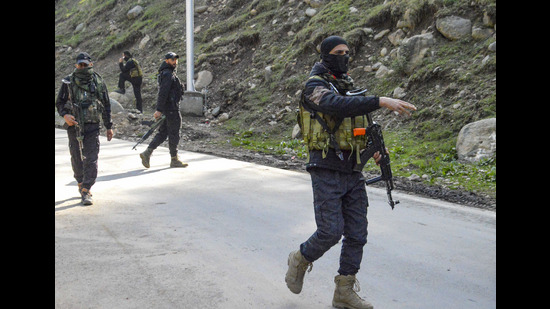Jammu to Pahalgam, the terror grid in J&K
How infiltration from across LoC in Jammu may have contributed to the attack on tourists on Tuesday
The terrorist attack in Pahalgam that claimed the lives of at least 26 tourists on April 22, 2025, has stunned the nation. This is one of the largest attacks on civilians in the Kashmir Valley since the 1990s. Despite the prolonged unrest in Jammu and Kashmir (J&K), tourists have rarely been targeted by terrorists since such actions adversely affect the local economy. The attack came against the backdrop of US Vice President JD Vance’s visit to India, a booming tourist season, and ahead of the Amarnath Yatra that is due to commence in July. The attack is a message to the local and global audience and aimed at undermining the perception of normalcy in J&K.

There is a likely connection between the Pahalgam terror attack and the revival of terrorism in the Jammu division in the last couple of years. The terrorists who executed the dastardly Pahalgam strike are likely those that infiltrated the Line of Control (LoC) in the Jammu division — in Poonch-Rajouri and Kathua-Samba sectors.
The Jammu division, after a decade of calm, has witnessed a resurgence of terror since 2021. Currently, People’s Anti-Fascist Front (PAFF) and Kashmir Tigers (KT) are operating in the Jammu division with almost clearly earmarked Area of Operations. Based on our open-source intelligence analyses, we found that between April 2024 and March 2025 there were 16 incidents of firing between the security forces and terrorists. In these firings, 11 terrorists were killed and 14 security personnel died.
Kathua shares the border with Pathankot in Punjab and Chamba in Himachal Pradesh (HP). Kishtwar and Doda also share the border with Chamba. In face of mounting pressure in Doda-Kathua-Kishtwar-Udhampur (DKKU) region, a likelihood of the terrorists moving into Chamba cannot be ruled out. Since July 2024, the government has also beefed up the security apparatus in the Jammu division, with measures such as the induction of 500 commandos and the creation of a permanent National Security Guard (NSG) hub in Jammu City. Despite this revamp, infiltration through the international border (IB) has continued.
The Indian Army’s 16 Corps under Northern Command is deployed along the LoC and in the hinterland of Jammu division, working effectively with the Rashtriya Rifles (RR), and Jammu and Kashmir Police (JAKP) in a multi-tiered counter-infiltration and counterterrorism (CT) grid. However, a similar grid is non-existent in the IB sectors of Kathua and Samba where the BSF is deployed in the show-window and the hinterland is manned by Yol-based 9 Corps under Western Command that is not deployed in a CT role and is oriented for more conventional roles. The deployments in Kathua-Samba sector present a fault line owing to the jurisdictional overlap between the home ministry which controls the BSF and the defence ministry which controls Northern and Western Commands.
Lack of real-time coordination and intelligence-sharing coupled with a weaker CT grid and ambiguous accountability of different agencies have worked to the advantage of terrorists in DKKU. The redeployment of the Uniform Force of RR, from Ladakh back to Reasi in Jammu division, is expected to strengthen the CT grid by filling up the void that was exploited by the terror groups.
Udhampur, Doda, and Kishtwar have a CT grid in place, but the lack of a similar deployment in Kathua weakens the overall disposition. Strengthening the security grid in Kathua requires a comprehensive approach involving the RR, BSF and JAKP. The anti-infiltration grid along the LoC has been strengthened in the past few years and this is evident from the decreasing number of infiltrations in Kashmir division. Addressing the existing gaps along the IB is a necessity to establish dominance and operational superiority in the region. It is the existing gaps in the IB sector to include Samba-Kathua region that has been exploited for consolidation by terror cadres to build up for striking in Pahalgam.
According to media reports, The Resistance Front (TRF), an affiliate of Lashkar-e-Taiba (LeT) has claimed the Pahalgam strike, although this has not been conveyed through TRF’s social media handle. Involvement of the Kashmir Tigers cadres in the Pahalgam strike remains a possibility. Irrespective of the outfits involved, the signatures of Pakistan and ISI are more than evident, with intent to divert attention from the multiple crises faced by Pakistan.
Considering present voids in the Kathua-Samba sector, there is a need to revisit the deployment of security forces in DKKU. The effectiveness of redeployment must be a function of various security agencies working out an integrated plan and joint execution. In addition, a strategic messaging requires to be carried on part of the government to convey that the claims of the terror groups like TRF, KT and PAFF being about the interests of local population is hollow -- given the fact that tourists were targeted in Pahalgam with obvious adverse fallouts on the local economy and livelihoods. Also, there is a necessity of re-forming a Unified Command in J&K, involving all security agencies and the local government for a seamless counter terror campaign. At the macro level, with no diplomatic exchange taking place with Pakistan, perhaps the government is left with minimal options but to send a military message to Rawalpindi that controls the terror groups in J&K.
Shashank Ranjan (retd) is a former colonel of the Indian Army with substantial experience of serving in counter-terror environments, and presently teaches at OP Jindal Global University. Mohit Vashisth is a doctoral candidate at OP Jindal Global University. The views expressed are personal
All Access.
One Subscription.
Get 360° coverage—from daily headlines
to 100 year archives.



HT App & Website







